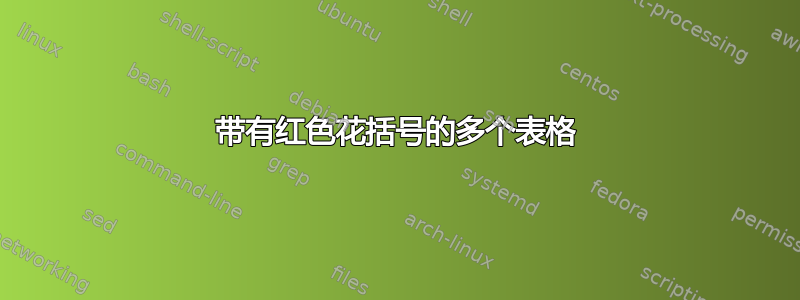
我正在尝试重现下图:
但到目前为止我唯一能做的是(但我无法改变花括号的颜色,也无法将多个表格放在同一个花括号中):
\documentclass[11pt]{report}
\usepackage{textcomp}
\usepackage{amsmath}
\usepackage{array, multirow, bigdelim, makecell, booktabs}
\begin{document}
\begin{center}
\renewcommand{\theadfont}{\normalsize\bfseries}
\begin{tabular}{c c c c l}
\cmidrule{2-4}
& $1$ & $2$ & $3$ & \hspace{0.3em}\rdelim\}{11}{*}[Discernable ($A\neq B$)]\\
\cmidrule{2-4}
\ldelim\{{9}{*}[$9$ distinct states] & $AB$ & $\ldots$ & $\ldots$ \\
& $\ldots$ & $AB$ & $\ldots$ \\
& $\ldots$ & $\ldots$ & $AB$ \\
& $A$ & $B$ & $\ldots$ \\
& $B$ & $A$ & $\ldots$ \\
& $A$ & $\ldots$ & $B$ \\
& $B$ & $\ldots$ & $A$ \\
& $\ldots$ & $A$ & $B$ \\
& $\ldots$ & $B$ & $B$ \\
\end{tabular}
\end{center}
\end{document}
感谢您的帮助...
答案1
您可以使用 来执行此操作tikzmark。
将每个表放在tikzmarknode具有不同名称的表中。然后,您可以创建一个tikzpicture带有选项的overlay, remember picture表,并使用 Ti钾Z. 该decorations.pathreplacing库具有内置brace样式,非常有用。垂直线可以用类似的方法绘制。
\documentclass[11pt]{report}
\usepackage{textcomp}
\usepackage{amsmath}
\usepackage{array, multirow, bigdelim, makecell, booktabs}
\usepackage{tikz}
\usetikzlibrary{tikzmark, decorations.pathreplacing, arrows.meta}
\tikzset{mybrace/.style={decorate, decoration={brace, amplitude=2mm}, red, thick}}
\begin{document}
\begin{center}
\renewcommand{\theadfont}{\normalsize\bfseries}
\tikzmarknode[outer xsep=1mm]{A}{\begin{tabular}{c c c}
\midrule
$1$ & $2$ & $3$\\
\midrule
$\ldots$ & $AB$ & $\ldots$ \\
$\ldots$ & $\ldots$ & $AB$ \\
$A$ & $B$ & $\ldots$ \\
$B$ & $A$ & $\ldots$ \\
$A$ & $\ldots$ & $B$ \\
$B$ & $\ldots$ & $A$ \\
$\ldots$ & $A$ & $B$ \\
$\ldots$ & $B$ & $B$
\end{tabular}}
\vspace{5mm}
\tikzmarknode[outer xsep=1mm]{B}{\begin{tabular}{c c c}
\midrule
$1$ & $2$ & $3$\\
\midrule
$AA$ & $\ldots$ & $\ldots$ \\
$\ldots$ & $AA$ & $\ldots$ \\
$\ldots$ & $\ldots$ & $AA$ \\
$A$ & $A$ & $\ldots$ \\
$A$ & $\ldots$ & $A$ \\
$\ldots$ & $A$ & $A$
\end{tabular}}
\vspace{5mm}
\tikzmarknode[outer xsep=1mm]{C}{\begin{tabular}{c c c}
\midrule
$1$ & $2$ & $3$\\
\midrule
$A$ & $A$ & $\ldots$ \\
$A$ & $\ldots$ & $A$ \\
$\ldots$ & $A$ & $A$
\end{tabular}}
\end{center}
\begin{tikzpicture}[overlay, remember picture]
\draw[mybrace](A.south west)--node[left=2mm, text=black]{9 different states}(A.north west);
\draw[mybrace](B.south west)--node[left=2mm, text=black]{6 different states}(B.north west);
\draw[mybrace](C.south west)--node[left=2mm, text=black]{3 different states}(C.north west);
\draw[mybrace](B.north east)--node[right=2mm, text=black]{Indistinguishable}(B.north east|-C.south east);
\draw[thick, red, Latex-]([xshift=-3.5cm]C.south west)--
node[sloped, above, align=center, text=black]{Some long text\\on two lines}([xshift=-3.5cm]C.south west|-A.north west);
\end{tikzpicture}
\end{document}
答案2
在一张 TikZ 图片中:
matrix对于分隔符,fit找到两个节点的边界,positioning(below=of …见node distance)和arrows.meta作为Triangle小费。
代码
\documentclass[tikz]{standalone}
\tikzset{
@/.style 2 args={
#1 Delimiter/.style 2 args={append after command={
\bgroup[every #2 delimiter/.append style={##2}]
nodealso[#2 delimiter={##1}](\tikzlastnode)\egroup}}},
@/.list={{Left}{left}, {Right}{right}}}
\usetikzlibrary{arrows.meta, fit, positioning, matrix}
% An alternative to Left Delimiter and Right Delimiter:
%\DeclareDocumentCommand{\tikzbrace}{m O{} m}{
% \path[every #1 delimiter/.append style={#2}] node also[#1 delimiter={#3}]}
\begin{document}
\begin{tikzpicture}[
node distance=.5cm,
every delimiter/.append style=red,
braced/.style={inner xsep=+0pt}]
\node[
braced,
Left Delimiter =\{{label=left:9 different states},
Right Delimiter=\}{label={[name=Dis]right:Discernables ($A \neq B$)}}
] (mb) {$
\begin{array}{ccc}
\hline
1 & 2 & 3 \\ \hline
AB & \cdots & \cdots \\
\cdots & AB & \cdots \\
\cdots & \cdots & AB \\
A & B & \cdots \\
B & A & \cdots \\
A & \cdots & B \\
B & \cdots & A \\
\cdots & A & B \\
\cdots & B & A \\ \hline
\end{array}$};
\node[
braced, below=of mb,
Left Delimiter=\{{label=left:6 different states}
] (be) {$
\begin{array}{ccc}
\hline
1 & 2 & 3 \\ \hline
AA & \cdots & \cdots \\
\cdots & AA & \cdots \\
\cdots & \cdots & AA \\
A & A & \cdots \\
A & \cdots & A \\
\cdots & A & A \\ \hline
\end{array}$};
\node[
braced, below=of be,
Left Delimiter=\{{label=left:3 different states}
] (fd) {$
\begin{array}{ccc}
\hline
1 & 2 & 3 \\ \hline
A & A & \cdots \\
A & \cdots & A \\
\cdots & A & A \\ \hline
\end{array}$};
\node[
fit=(be)(fd),
inner sep=+0pt,
Right Delimiter=\}{label=right:{Indistignuishable ($A = B$)}}]{};
\node[align=left, anchor=north west] at (mb.north-|Dis.west) {
Example:\\
Two particles: $A$ and $B$\\
Three states: 1, 2 and 3};
\draw[red, thick, -Triangle] (current bounding box.north west)
-- node[above, black, rotate=90, align=center] {
More restrictive: when a particle is in a negative state,\\
less states are available for the other particles.
} (current bounding box.south west);
% Here's the alternative to Left Delimiter and Right Delimiter:
%\tikzbrace{left} [label=left:9 different states] \{ (mb);
%\tikzbrace{right}[label=right:Discernables ($A \neq B$)] \} (mb);
%\tikzbrace{left} [label=left:6 different states] \{ (be);
% and so one …
\end{tikzpicture}
\end{document}





